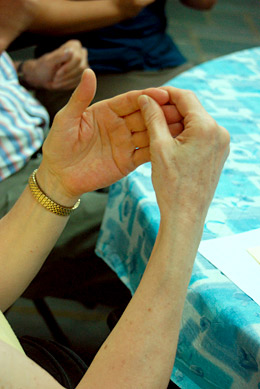A Different Dialogue
For today’s cozy congregation of four, the sense of alienation is all too familiar. Using a fork to scoop a wad of confetti’ed icing from the birthday cake, Sam remembers his dismal first experiences at church.
“I was terribly bored,” he says through Alex’s interpretation. “No one was communicating with me. My parents would tell me to go on a hike, or a picnic — to do something else while they were there.”
Sam came to St. Ann’s when he was 28, after a deaf friend suggested they check out the church’s weekly movie night event. Sam is Jewish, which didn’t bother him or anybody else. What he craved was a social life. And that’s what he found.
For John, it was an education at St. Joseph’s Catholic School for the Deaf that brought religion to a life he describes as “a football game on ‘mute.’” Though he can’t hear, John still cares who wins and loses.
But that was years ago. Now, it’s been a persistent challenge for the ministry to get deaf youth involved. The Episcopal Conference for the Deaf struggles to find enough interpreters for their churches, and enough ministers trained and experienced in pastoral counseling. Rev. Barbara Allen, First Vice President of the ECD, says their greatest obstacle is ultimately the expense.
“Interpreter fees are almost cost-prohibitive,” she says. “Working with deaf youth is a real challenge. But I’ve begun to realize that sometimes deaf children, like hearing children, have a better understanding of God than adults because they’re innocent and open to new ideas.”
To extend its outreach to a younger generation, the ECD offers chaplaincy to schools for the deaf. Rev. Allen is the Episcopal chaplain to Gallaudet University, Rev. Selfe’s alma mater.
But St. Ann’s regulars remain elderly, as it’s always been. Despite the lack of youth participation, Alex doesn’t view it as a problem for the church: “We’re here to serve a niche; these are the people that need us. So that’s what we’re here for.”
Rev. Selfe nods emphatically. “It’s not about words,” she adds. “You can talk to God the same way, whether you’re eight, or 90. Everybody experiences God differently.”
For Evelyn Schater, a middle-aged graphic designer who has been coming to St. Ann’s for eight years, faith will always remain a fundamental part of reconciling the obstacles her deafness has presented her as a professional. An immensely talented artist, Schater attended Pratt, the School of Visual Arts, and the Fashion Institute of Technology, and she had worked as an assistant under Takashi Murakami — a prolific artist who has created prints for fashion label Louis Vuitton.
After months of working with an interpreter for Murakami, Schater was asked to leave. The communication gap was “slowing them down,” she recalls, and she was forced to find another job.
“That’s the deaf life,” she tells me in perfectly voiced English. She shakes her head of wispy locks tied back, eyes pale and wide. “I have my strengths. My weakness was given to me, but as long as I have my faith, I know I’ll be able to find a job somewhere, somehow. I’ve been looking all my life. How do you think I keep going?”
But for most, a relationship with God hasn’t always been easy. The frustrations of accepting their deafness was often the most difficult to overcome in building a spiritual rapport.
“I was angry at God. I said, ‘Why did you make me deaf?” said Keane Lewis, a congregation member in her thirties. She spoke through an interpreter, and said that it was only after she moved into a building where all residents were deaf or hard of hearing that she finally accepted her own disability. “I saw that the deaf can own an apartment, the deaf can drive, and it can be a beautiful experience. When I go home, I take off my hearing aids to feel more deaf — to be in that world. I accepted, and I connected with God.”

